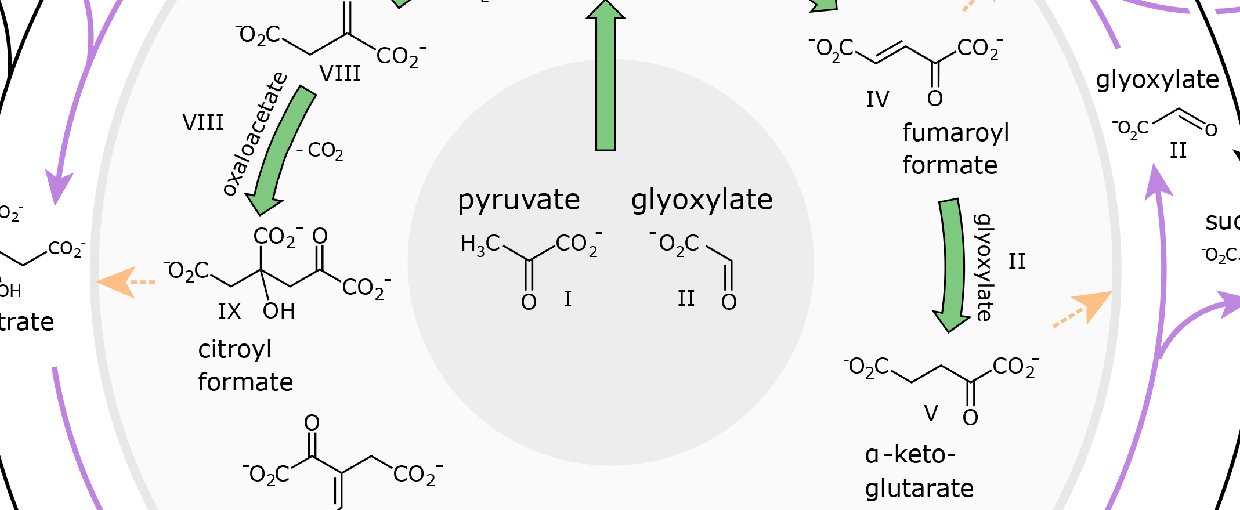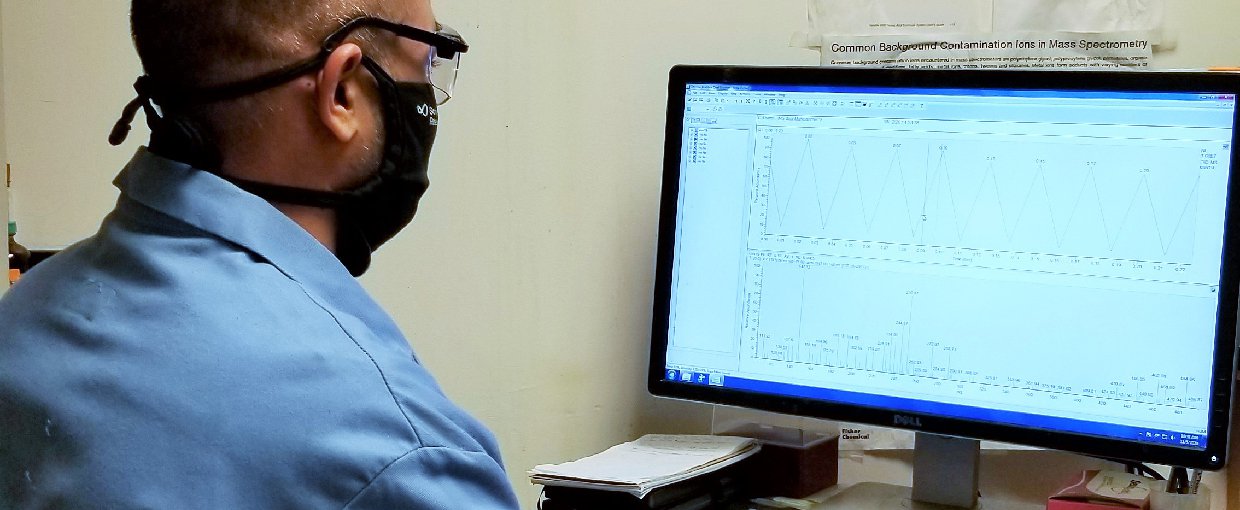Written byAaron GronstalSource
NASA Astrobiology

A new study supported by the NASA Astrobiology Program looks at the origins of metabolism on the early Earth before the advent of enzymes and in the absence of metals.
Reactions in Cells
All life as we know it is powered and maintained by an intricate web of chemical reactions that is constantly occurring inside cells. This collection of reactions is referred to as metabolism and is responsible for converting food into the energy and molecules needed for survival, and for removing harmful waste products from cells.
Among the myriad reactions found in living cells today, there are specific metabolic pathways that are thought to be crucial for life as we know it. These reactions are the most basic chemical reactions that living cells need to function, and they (or ones very similar to them) would have been necessary for the origin of life on the ancient Earth.
Understanding how chemical pathways for biology began to operate on the early Earth is an essential step in understanding how life on our planet began; yet, many important questions about their prebiotic roots remain unanswered. Where did the components for these reactions come from? Which components came first? Which reactions came first? These are questions that origin of life researchers have been puzzling over for decades.
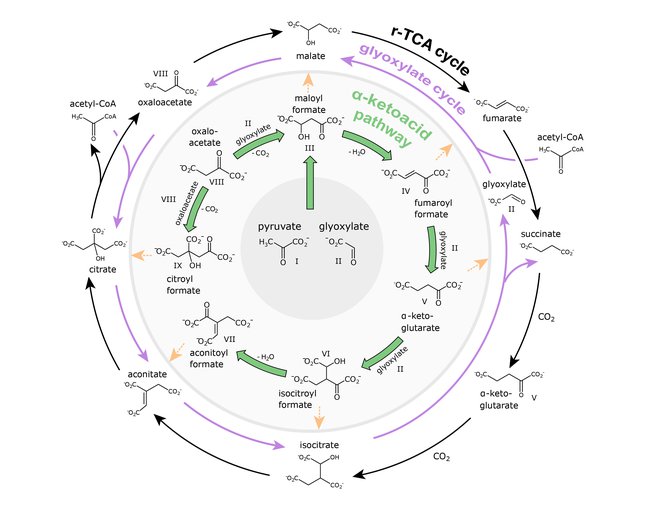
Illustration of the alpha-ketoacid pathway identified in the recent Nature publication.Image credit: Stubbs et al. (2020).
Puzzling Out the Pieces
A key component of metabolic reactions in cells are substances known as enzymes and cofactors, which help to catalyze reactions or, in other words, help to make reactions go faster. Cofactors are substances that must be present in order for an enzyme to do its job.
Many chemical reactions that are important for the metabolism of living organisms can occur naturally outside of cells. However, these reactions are slow, or are hindered by other substances and environmental conditions present in nature. It is enzymes that encourage reactions along, helping them pick up the pace to produce energy and essential molecules for living cells. It has been theorized that without enzymes, the metabolisms of living organisms wouldn’t work.
Many enzymes are complicated molecules made of protein, and they are produced inside cells through chemical reactions. So, it is difficult to imagine how these essential molecules would have been available for reactions in the first living cells on Earth if the cells themselves weren’t there to produce them. However, other substances, including some metals found in minerals and metalloenzymes, can perform functions similar to enzymes, and act to catalyze chemical reactions. Because of this, many origin of life researchers have focused their research on metals that are present in metalloenzymes that might have acted in the place of enzymes and cofactors on the early Earth. The idea is that reactions would have first used metals as catalysts, and over time these reactions led to more and more complicated pathways that eventually produced, and then began to use, enzymes.
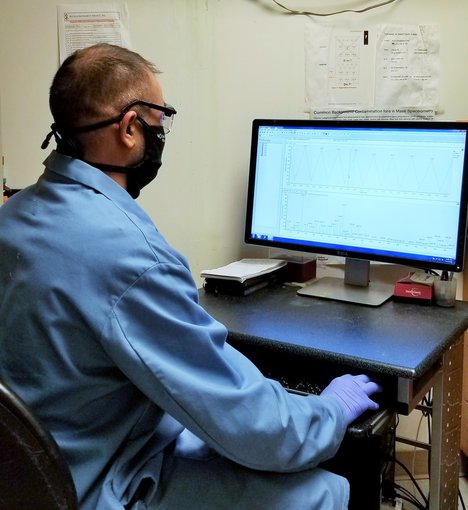
Co-author Fnu Mahipal performing the mass analysis of a reaction of pyruvate and glyoxylate in Krishnamurthy lab.Image credit: Mahipal/Krishnamurthy/Scripps Research Institute.
Focusing on the Citric Acid Cycle
One of the reactions of particular interest for early life is the citric acid cycle (aka the TCA or Krebs cycle). The citric acid cycle is a series of reactions that aerobic organisms (those that require free oxygen) use to produce energy from food. By starting with the components of the citric acid cycle today and working backwards, researchers have been attempting to reconstruct possible ancient pathways that could have been precursors to the modern-day cycle.
The trick is that the reactions need to form bonds between molecules of carbon in order for those reactions to be ‘productive’ in terms of life. And, thus far, none of the precursor reactions are able to do that in prebiotic conditions without enzymes.
A research team supported in part by the NASA Astrobiology Program has now provided new insight into a prebiotic citric acid cycle. Importantly, their work shows that enzymes may not have been critical to life’s first metabolic reactions. Instead of working backwards from the modern-day cycle, the team took a ‘bottom-up’ approach to the question of early metabolism. They looked at how basic molecules interact and give rise to simple chemical reactions, a method that has led to some surprising results.
Piecing Together the Puzzle
Rather than starting with the modern-day citric acid cycle, the team has been looking at molecules that might have been present on the early Earth and using them to construct different pathways that could have eventually led toward the chemistry of life that we see today.
“Discovering the origins of metabolism is a bit like trying to understand the route taken by a modern road – you’ve got to consider the limitations of the horse that walked the original trail,” explains co-author Greg Springsteen of Furman University. “We’ve taken a similar approach to prebiotic chemistry. We didn’t try to force a synthesis that made the molecules of modern biology, but rather took small chemical building blocks and followed their chemistry broadly through the types of transformations that we see in modern life… reactions like aldol additions, dehydrations, and reductions/oxidations.”
The research team, which includes members from Furman University and the Scripps Research Institute (TSRI), focused on small molecules called glyoxylate and pyruvate. These molecules contain just two and three carbons respectively, and they are good at forming carbon-carbon bonds.
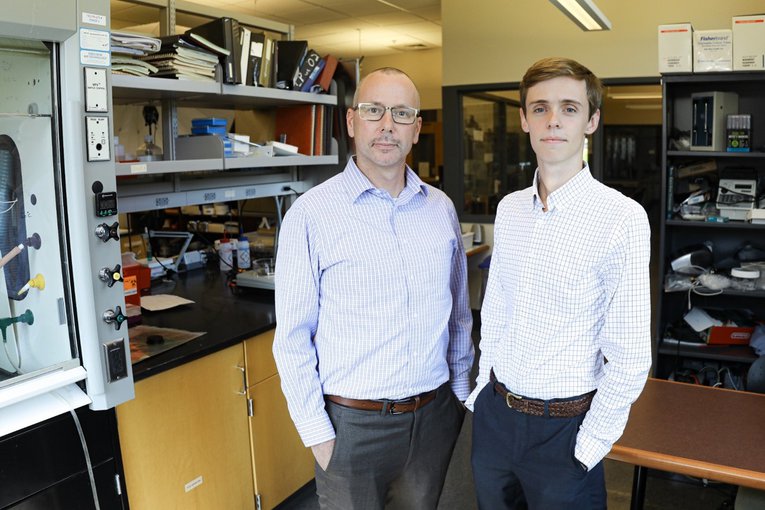
Greg Springsteen (left), Professor of Chemistry at Furman University, and 2020 Furman graduate Trent Stubbs (right).Image credit: Jeremy Fleming/Furman University.
Previously, the team showed that pyruvate and glyoxylate could be used to produce other molecules that are used in the citric acid cycle (namely malate and oxaloacetate). Their work is a bit like putting together a puzzle where you have to figure out how to build the pieces first. You know what the end picture is supposed to look like, but you have a mess of tiny pieces that first need to be used to construct the puzzle pieces that eventually make up end picture. Malate and oxaloacetate are two of the puzzle pieces needed to build the citric acid cycle. The new study expands the number of puzzle pieces that the team now knows how to build; and they’ve shown that they can build those pieces without catalysts.
The new paper shows that, under the right conditions, pyruvate can produce analogs of a-ketoacids used in the citric acid cycle. What is particularly important about the new work is that the reaction can happen without enzymes or metal catalysts. All that is required is some pyruvate, some glyoxylate, and an environment that contains water with relatively mild conditions (for the early Earth).
The transformation of pyruvate into analog components for the citric acid cycle could be considered a proto-metabolic pathway (a reaction similar to those used by life today, but that happened prior to the origin of life).
“Watching these transformations proceed through a pathway directly analogous to the citric acid cycle, step-by-step, was even more gratifying because it wasn’t at all what we were looking for,” comments Springsteen. “We were following, rather than leading, the chemistry.”
The alpha-ketoacid analogs are important, because they are used in making all kinds of other molecules that are used in the citric acid cycle. alpha-ketoacids can also be used to synthesize amino acids through naturally occurring reactions. Amino acids are one of the fundamental pieces of life and serve as the building blocks for proteins.
“To our great surprise, when we added the two smallest a-ketoacids to buffered water at mild temperatures, a reaction pathway began that walked step-by-step through the alpha-keto acid analogs of the first six intermediates of the citric acid cycle. This chemistry was as clean and easy as it was unexpected,” says Springsteen.
The study reports an analog of the citric acid cycle that uses only alpha-ketoacids that are similar to those used as intermediates in the modern-day citric acid cycle. This newly identified pathway uses only two reactants, pyruvate and glyoxylate, and can occur in relatively mild conditions without transition metals.
“Some of the reactions we saw in the pathway were very unexpected, particularly under such mild conditions,” explains Springsteen. “By adding just two atoms to the modern citric acid cycle intermediates, (the CO of the ketoacids), the chemistry was able to proceed without specific enzymatic or inorganic catalysts.”
Ultimately, a big takeaway from the new study is that it provides a potential route from pyruvate to amino acids, without the need for catalysts. Using only alpha-ketoacids (with no catalysts or extreme environmental conditions), this primordial pathway could have become active on the early Earth. The work shows a plausible foundation from which the modern citric acid cycle, with its sophisticated system of catalysts and cofactors, could have eventually evolved.
“We certainly did not set out to discover an analog to the citric acid cycle, and we were very surprised to find one,” said Springsteen.
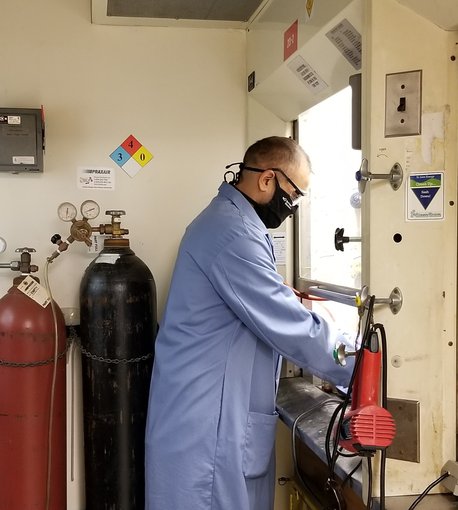
Co-author Mahipal performing a reaction of pyruvate and glyoxylate in Krishnamurthy lab.Image credit: Mahipal/Krishnamurthy/Scripps Research Institute.
Expanding Recent Knowledge
The results of the study suggest that the newly identified reaction could have emerged before life, and might have been a step toward more complicated pathways that would require catalysts. A European study from 2019 also proposed a chemical reaction network that would lead from pyruvate and glyoxylate to intermediates of the citric acid cycle (https://www.nature.com/articles/s41586-019-1151-1). However, the pathway presented in this study required the presence of ferrous iron (Fe2+).
“Our work shows that Fe2+ is not necessary,” says co-author Ramanarayanan Krishnamurthy of TSRI. “The reaction proceeds much better in the absence of Fe2+ because glyoxylate itself can act as the reducing agent. And, apart from acting as a reductant (by hydride transfer), glyoxylate reacts further to a more complex molecule that breaks down to give alpha-ketoglutarate and formate. Therefore, the two different reaction pathways leading to the same key intermediate alpha-ketoglutarate shows the convergence of this system. And, the credit goes to the ingenuity of Dr. Mahipal Yadav who discovered that this second pathway is equally important as the glyoxylate acting as a direct reductant.”
“Moreover, it is the dissolved oxygen (or an equivalent oxidant) in the aqueous medium that is responsible for the oxidative degradation of the alpha-ketoacids. Fe2+ is only a catalyst and without an oxidant, the Fe+2 on its own, is not capable of breaking down the alpha-keto acids to the carboxylic acids seen in the non-enzymatic version of the rTCA pathway” explains Krishnamurthy.
On the Early Earth
Scientists don’t exactly know what the environmental conditions of the early Earth were like, and there is also no definitive evidence of the types of molecules that were present at the time of life’s origins.
By its nature, pyruvate breaks down quickly and it is unlikely that the molecule would be preserved in geological samples. So, there isn’t definitive proof that it was present on the early Earth, but some experiments have shown that it could’ve been possible.

The Krishnamurthy Lab at the Scripps Research Institute.Image credit: Ramanarayanan Krishnamurthy/Scripps Research Institute.
“There have been publications that point to the likely formation of glyoxylate and pyruvate by prebiotically plausible chemical pathways on early Earth. However, since these are reactive intermediates they would be hard to keep around for long time and, therefore, would be difficult to detect in any ancient samples,” explains co-author Ramanarayanan Krishnamurthy of TSRI. Krishnamurthy is also a co-lead of the NASA Astrobiology Program’s Research Coordination Network (RCN), Prebiotic Chemistry and Early Earth Environments (PCE3).
Many of the chemical pieces needed to make pyruvate could have been present on the early Earth, and pyruvic acid (the conjugate base of pyruvate) has been detected in ancient samples (https://www.pnas.org/content/108/34/14015). Krishnamurthy and his team have previously shown that glyoxylate can be produced from glycine and formaldehyde (https://www.thieme-connect.de/products/ejournals/abstract/10.1055/s-0036-1588657), and glyoxylate has also been shown to form in materials that simulate interstellar ices (https://onlinelibrary.wiley.com/doi/10.1002/anie.201901059).
“Thus, there is reason to believe that glyoxylate and pyruvate could have been present on the early Earth,” says Krishnamurthy.

Co-author Mahipal processing the NMR data of a reaction of pyruvate and glyoxylate in Krishnamurthy lab.Image credit: Mahipal/Krishnamurthy/Scripps Research Institute.
A Multi-Institution Effort
The new study was the result of research from a team with a diverse set of experiences and backgrounds. Principal Investigators (PIs) on the project included Professor Springsteen at Furman, classified as a liberal arts University, and Professor Krishnamurthy at TSRI, which is classified as a Research 1 University. Co-author Mahipal Yadav is a postdoctoral researcher at TSRI. First author Trent Stubbs was an undergraduate student at Furman University at the time of the study.
“I started my project during the Fall semester of my Sophomore year in 2017 and worked on it every subsequent summer and term until I graduated from Furman University last May,” says Stubbs, who is now pursuing a PhD in chemistry at Emory University in Atlanta, Georgia.
Origin of life research is a field that most scientists approach as they specialize later in their educational careers. As an undergraduate, Stubbs was not your typical researcher in a prebiotic chemistry laboratory, nor your typical first author on a research paper in a high impact journal. But according to Stubbs, it was the captivating questions of the field that drew him in.
“Prebiotic chemistry is unique in that our hypotheses are often story-driven,” says Stubbs. “We can apply the organic chemistry principles taught in the classroom to rationalize prebiotically plausible chemical systems.”
As a whole, astrobiology encompasses a wide range of disciplines, which are rapidly advancing in terms of the technologies involved and the discoveries being made. The broad and adaptable nature of the field offers numerous opportunities for researchers at all stages of their education and career to not only participate, but to make valuable contributions and advance the field.
“Astrobiology is a unique field as it is the culmination of efforts between chemists, biologists, physicists, geologists, astronomers, and many more,” says Stubbs. “Wherever a student’s specific interests fall, there are always ways to apply concepts to understanding how Life began, and where else it could emerge.”
The study, “A Plausible Metal-Free Ancestral Analogue of the Krebs Cycle Composed Entirely of a-Ketoacids” was published in the journal Nature Chemistry. The work was supported in part by the Exobiology Program and the NSF/NASA Center for Chemical Evolution (CCE) at the Georgia Institute of Technology in Atlanta, Georgia. The CCE is a collaborative program supported by the National Science Foundation (NSF) and the NASA Astrobiology Program.
References and Related Links:
Ayala-Castro et. al. (2008) Fe-S Cluster Assembly Pathways in Bacteria. Microbiology and Molecular Biology Reviews. DOI: 10.1128/MMBR.00034-07
Nitschke et. al. (2013) On the antiquity of metalloenzymes and their substrates in bioenergetics. Biochimica et Biophysica Acta (BBA) – Bioenergetics. DOI: 10.1016/j.bbabio.2013.02.008
